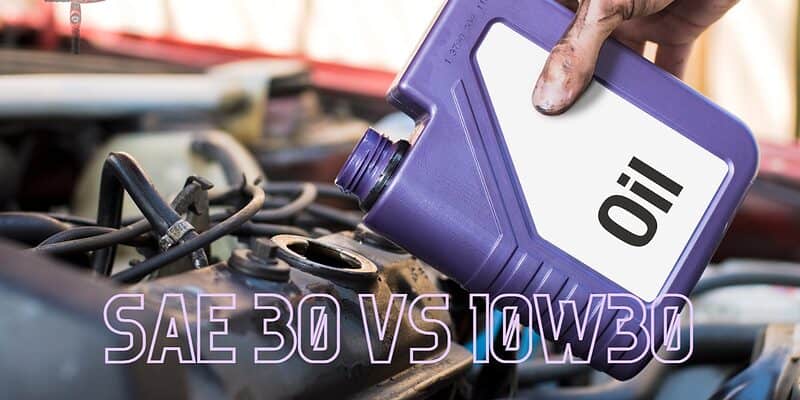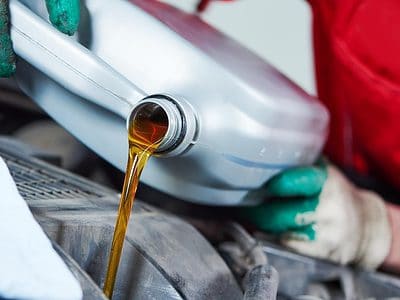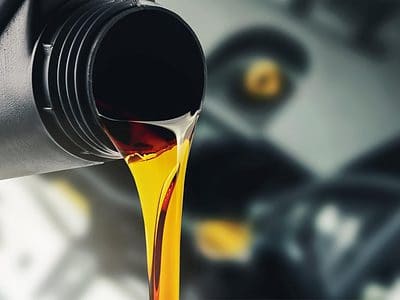
Having the correct type of oil is crucial for good engine performance. Certain oils work better than others, depending on the engine type and the climate of the operation area. SAE 30 and SAE 10W30 are common oil choices for engines.
But the main question is, which of them should you go for? This article will compare SAE 30 vs 10W30 and help you select the right oil for your car!
What Is SAE 30?
To begin with, SAE stands for the Society of Automotive Engineers. The association formed the current oil classification system, which is based on viscosity. Following the guidelines, motor oils have a viscosity rating of 0–50. A good example is SAE 30, with a viscosity of 30, which is high enough for most cars and trucks.
The SAE 30 can withstand high temperatures without degeneration. Hence, it is unlikely to form any deposits and sludge, which will otherwise block your engine and reduce its efficiency. Its weight also makes it very efficient at lubricating engine parts even when they get very hot during operation.
What Does 10W30 Mean?
The SAE 10W30 is a dual-rated oil, and it’s thinner than its SAE 30 counterpart. The “30” in the name signifies that it has the same viscosity as the SAE 30 oil at high temperatures. However, due to its thinness, it can never be as thick as the SAE 30 when it is cold.
Hence, the “10W” represents the cold viscosity of the oil. This means that the oil will have a viscosity of “10” at winter temperatures (W). Therefore, it offers excellent engine lubrication and protection at low temperatures—this is invaluable to people who live in cold areas. Plus, it comes in regular and high-mileage options for older cars.
Is SAE 30 the Same as 10W30?
SAE 30 is not the same as 10W30. On the one hand, the SAE 30 is a single-weight oil. This means it fulfills a single viscosity specification, making it better applicable to engines that run at stable temperatures.
On the other hand, the 10W30 is a multi-weight oil, meaning it’s an oil that has different weights at different temperatures, making it better suited for modern engines which operate at various temperatures.
SAE 30 is also thicker, meaning it can preserve its properties at high temperatures. However, it is not able to compete with 10W30 when it comes to effectiveness in cold weather.
In comparison, the 10W30 is thinner and flows easily in cold weather. Yet it is not as effective in stopping the formation of engine deposits at high temperatures.
SAE 30 vs 10W30 Oil: Differences
Don’t get this wrong; these two products have much in common. But at the same time, they both have properties that make them more suitable for one job than the other. We shall be exploring these differences in a few moments.
Overall Performance
SAE 30 performs well when used in small cars, light trucks, and mini engines like lawnmowers and generators. It may be a tad more expensive, but it’s excellent for engines that are exposed to high temperatures for long periods.
The 10W30 also works great at high temperatures. But it also performs well in the cold as it has a low viscosity at such temperatures. This makes it an excellent choice for larger vehicles, especially for people living in places with wide-ranging climates.
Composition
While SAE 30 is mainly synthetic—containing detergents with additives to trap dirt—its SAE 10W30 counterpart is available in two forms, conventional & synthetic.
Oil Pressure
SAE 30 oil can resist a high amount of pressure. It has been tested for long periods under intense temperatures rising to 212 degrees Fahrenheit (100⁰C).
10W30, on the other hand, is thinner and cannot withstand as much pressure as the SAE 30. However, this is beneficial, as it gives your engine a prolonged life.
Viscosity
While both oils have the same viscosities in high temperatures, it is a different story when the temperatures are much lower. When the weather is cool, the 10W30 does not thicken as much as the SAE 30. This allows the 10W30 to flow in cold weather, kick-starting your engine much faster.
Operating Temperature
The SAE 30 is known to operate in hot conditions mainly. This means that in cold situations, it is unable to function optimally. Also, SAE 30 oil reaches its viscosity peak at around 212 ⁰F, but as soon as the engine temperature reaches 250–260 ⁰F, it starts to disintegrate. For it to remain useful, the engine’s temperature has to drop, along with that of the oil.
As for 10W30, it is usable in both hot and cold weather, being able to remain optimally functional in temperatures as high as 212 ⁰F and as low as 13 ⁰F. Like SAE 30, however, it starts to break down at about 260⁰F.
Average Price per Quart
The average price of a quart of SAE 30 oil is $10 – $15, while a similar measurement of 10W30 oil has an average cost of $5 – $10.
Pros and Cons of SAE 30 and 10W30 Oil
Both the SAE 30 and SAE 10W30 have their pros and cons. Let’s take a look at them.
SAE 30 Oil Pros
- High viscosity helps safeguard older engines
- Suitable for small engines (lawnmowers)
- Works well at high temperatures
SAE 30 Oil Cons
- Puts drag on the engine, slowing it down in the process.
- Not optimal for new cars
- Does not work as well in winter
SAE 10W30 Oil Pros
- Low viscosity at low temperatures
- Optimal for high mileage vehicles
- Slightly less expensive
SAE 10W30 Oil Cons
- Not as optimal in warmer weather
- Doesn’t provide as much safety to older vehicles
- Not very good for small engines
When To Use SAE 30
Cold weather aside, the SAE 30 is quite a good option anytime, any day. It is also a brilliant option if the vehicle engine is old—this will help protect the aging parts.
When to Use 10W30
If there are a lot of high-end fluctuations in weather conditions, this is undoubtedly the best time to utilize the 10W30 oil.
Which Oil Is Recommended for Low Temperatures?
For low temperatures, the ideal oil is the 10W30 oil due to its viscosity grade of 10. It can circulate freely in the engine, unlike the SAE 30, which may become too thick.
Which Oil Grade Is Ideal for Lawnmowers?
You can use SAE 30 and 10W30 in lawnmowers; however, they serve different purposes. While SAE 30 is a lightweight oil formulated for warmer temperatures, 10W30 is heavier and can work in hot and cold conditions.
Although most people tend to choose SAE 30 as their preferred choice of oil, if you live in a location with the possibility of freezing conditions, you may want to switch to 10W30 in the winter.
If you are still unsure of the oil to use, consult your owner’s manual—the preferred choice of lubricant should be there.
Why Is SAE 30 No Longer Used for Cars?
SAE 30 is no longer used in cars today as it is not a multi-grade oil. This means that it is not capable of performing well in all seasons. Therefore, the 10W30 is the better option between the two.
Can You Mix SAE 30 And 10W30?
Technically, you can mix SAE 30 And 10W30 because of their similarities. However, a case still has to be made for their existing differences, which might end up being the primary cause of damage to your engine.
Recommended SAE 30 and 10W-30 Oil Brands
There are several great brands that manufacture and sell quality SAE 30 and 10W30. Here are some of them:
- Valvoline
- Pennzoil
- Castrol
- Mobil 1
- VP Racing
SAE 30 vs 10W30: Which Should You Use?
SAE 30 vs 10W30. Now that you understand everything you need about these oils, consider the state of your engine and your environment, and use that information to get a suitable lubricant. Once you’ve decided on an oil, it’s important to check it regularly and change it when due.
FAQs
What Is SAE 30 Used For?
SAE 30 is commonly used for smaller engines like the ones found in small cars, generators, lawnmowers, and even chainsaws.
Can SAE 30 Be Used in a Car?
It is not advisable to use SAE 30 in modern cars, as they require multi-grade oils—which SAE 30 isn’t. That said, you could be used in older vehicles, though, as their engines can function with such oil.
Is 10W30 Good for My Car?
Yes, 10W30 is good for your car. It is a multi-graded oil that can function in hot and cold temperatures.
Can I Use SAE 30 Instead of 10W30?
You shouldn’t use SAE 30 instead of 10W30. 10W30 has different temperature viscosities, while SAE 30 is fixed.
Can I Use 10W30 Instead of SAE 30?
It’s much more reasonable to use 10W30 in place of SAE 30. 10W-30 behaves similarly to SAE 30 at hot temperatures, with the added advantage of cold temperature suitability.
















